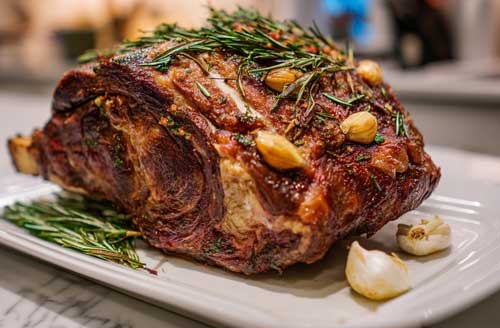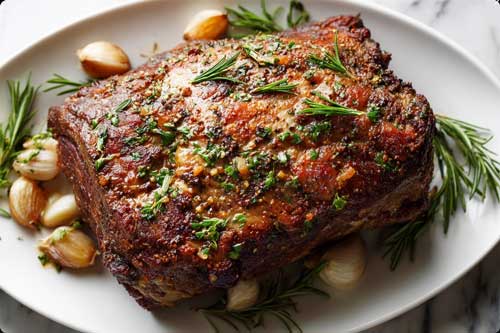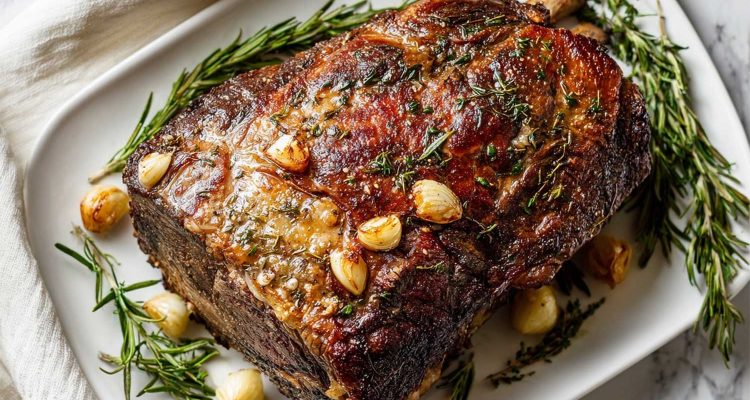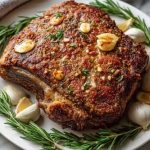Prime rib has always been the kind of roast that shows up at Christmas tables, family dinners, and celebrations. But what if you could make it taste like the dry-aged beef from a fancy steakhouse—without needing a thousand-dollar fridge or weeks of patience? That’s what this recipe is about. It’s a way to “fake” the dry-aged prime rib right in your regular kitchen fridge, and it happens to fit perfectly into a keto lifestyle.
This method is sometimes called “fridge-aging” or “poor man’s dry aging.” Don’t let the name fool you. Done right, the flavor is insane—beefy, buttery, nutty—all the things that make steak lovers stop mid-bite and look around like did that just happen?
I’ll walk you through every step: how to pick the right cut, how to set up your fridge, how long to age it, how to season it, and how to cook it to get that restaurant-style crust with a melt-in-your-mouth center. And because I’ve been through the trial and error myself, I’ll share all the mistakes to avoid so you don’t end up wasting a pricey cut of meat.
Why This Recipe is great for Keto
Prime rib is naturally keto-friendly. No sugar, no flour, no carbs hiding in sauces. Just pure beef and fat. The dry-aging style makes the fat taste almost sweet, like butter that’s been toasted. And when you cook it right, you don’t even need a sauce—just salt, pepper, maybe some garlic or rosemary if you like.
If you’re on keto, this is one of those meals that feels like a cheat day but isn’t. The fat ratio is perfect, and it’s so satisfying that you won’t be reaching for snacks later.
What You’ll Need
The Meat:
- A prime rib roast, bone-in or boneless (between 4–7 pounds is best if it’s your first time).
- Bone-in gives extra flavor and looks gorgeous.
- Boneless is easier to cut later.
For Fridge-Aging:
- Plenty of paper towels or cheesecloth
- A wire rack that fits inside a sheet pan (to keep air circulating)
- Space in your fridge where the air can move around the roast
For Cooking:
- Kosher salt
- Fresh cracked black pepper
- Optional: garlic powder, fresh rosemary, or thyme
- Meat thermometer (you’ll thank me later)
Making The Best Keto Dry-Aged Style Prime Rib (Fridge-Aged)

Step One: Choosing the Right Prime Rib
Don’t stress about grabbing the absolute top-shelf “Prime” grade. USDA Choice rib roast will do just fine, and after fridge-aging, it’ll taste better than many Prime cuts cooked straight away.
Look for a roast with:
- Good marbling (the white streaks of fat through the meat)
- A thick fat cap (this is your flavor insurance)
- Bones if possible—they protect the meat during cooking
If your butcher looks at you weird when you ask for a rib roast, just say: standing rib roast. That’s the same thing.
Step Two: The Fridge Aging Setup
Here’s where the magic starts. Real dry-aging is done in special coolers with controlled humidity and airflow. We’re faking that by using your fridge.
- Pat your roast dry with paper towels.
- Wrap it loosely in fresh paper towels or a single layer of cheesecloth. Don’t wrap it like a mummy, just a light cover.
- Place it on a wire rack over a sheet pan. This keeps air moving all around.
- Put it in the coldest part of your fridge where it won’t get touched.
Now leave it.
How long?
- 3 days: noticeable improvement, deeper beef flavor
- 5–7 days: bolder, nuttier flavor, firmer texture
- 10 days: steakhouse-level taste, but some folks get nervous keeping it that long
I usually go for 5 days. It’s the sweet spot where the meat loses some water, the fat firms up, and the outer crust forms.
Each day, check the towels. If they’re damp, change them. Don’t freak out if the outside darkens. That’s normal.
Step Three: Trimming After Aging
When you pull the roast out, the outside may look a little scary. It might be dark brown or almost purple. That’s good. That’s flavor.
- Slice away just the thinnest layer of dried-out meat and fat.
- Don’t go crazy trimming. You paid for that roast—most of it is still perfect.
Now you’ll see the inside is still bright, ruby red. That’s your dry-aged prime rib ready to be seasoned.
Step Four: Seasoning
Less is more. The dry-aged flavor doesn’t need a lot of help.
- Coat the roast generously with kosher salt and black pepper.
- If you want, rub with a little garlic powder or fresh rosemary.
- Let it sit uncovered in the fridge for at least 2–4 hours, or overnight if you can. This extra rest lets the salt sink in and dries the surface even more (which means a better crust later).
Step Five: Cooking Method (Reverse Sear Style)
This is where most people either win the meal or ruin it. Prime rib isn’t cheap, so treat it with some respect. Forget blasting it at high heat right away. Slow and steady wins here.
The Game Plan:
- Preheat oven to 250°F.
- Place your roast bone-side down (or fat side up if boneless) on a rack over a roasting pan.
- Cook low and slow until the internal temp hits:
- 120°F for rare
- 125°F for medium-rare (my favorite)
- 135°F for medium
This will take about 2.5–3 hours for a 6-pound roast, but don’t go by time—go by thermometer.
The Sear:
Once it hits your target temp, pull it out. Crank your oven to 500°F (or fire up a cast-iron skillet if you’re doing slices). When hot, put the roast back in for 8–10 minutes to crisp the crust.
That’s the part where the outside goes golden brown, and your kitchen smells like heaven.
Step Six: Rest and Slice
The hardest part: waiting. Rest the roast on a cutting board for at least 20–30 minutes. This keeps the juices inside instead of running all over your counter.
Slice thick, restaurant-style cuts. If you went bone-in, cut the bones off first, then slice against the grain.
Flavor Notes
If you’ve never had fridge-aged prime rib, here’s how it tastes compared to regular:
- The fat melts smoother, almost like butter
- The beef flavor is deeper, a little nutty, almost cheesy in the best way
- The crust is more intense because the surface was drier before cooking
It’s the kind of roast that makes you want to close your eyes when you chew.
Keto Serving Ideas
Keep it simple and keep it keto:
- With a side of creamed spinach (use heavy cream and parmesan)
- Garlic butter mushrooms sautéed in the beef drippings
- Cauliflower mash instead of potatoes
- Simple arugula salad with olive oil and lemon
Trust me, you don’t want to drown this roast in sauces. Let the meat speak for itself.
Common Mistakes to Avoid
- Over-aging: Don’t try to go 3 weeks in a home fridge. You don’t have the humidity control for that. 5–7 days is plenty.
- No thermometer: Guessing will ruin a $100 roast faster than anything.
- Skipping the rest: Cutting too early means dry meat. Patience pays.
- Too much seasoning: Don’t mask the natural dry-aged flavor.
My First Time Story

The first time I tried this, I thought I ruined the meat. It looked like a science project in the fridge—dark, shriveled, not exactly pretty. My wife gave me that what did you just waste money on look.
But after trimming, seasoning, and roasting, the smell that came out of that oven shut everyone up. We sliced it at the table, and the inside was pink and juicy, with this crust that tasted like beef candy. That was three years ago, and every Christmas since then, my family requests the “fridge-aged rib.”
Storage and Leftovers
Prime rib keeps well if you don’t slice it all at once.
- Store the roast unsliced in foil in the fridge up to 4 days.
- Reheat slices gently in a skillet with butter, not the microwave.
- Leftover slices make incredible keto sandwiches with lettuce wraps or low-carb bread.
One of my favorite tricks is chopping leftovers into chunks, searing them in butter, and tossing them into scrambled eggs. Breakfast of champions.
Conclusion
This keto-friendly fridge-aged prime rib is not just food—it’s a centerpiece. It’s the kind of dish that makes people linger at the table, talk about it the next day, and maybe even ask you to make it again before the plates are cleared.
It’s simple, it’s primal, and it tastes like you spent way more time and money than you actually did. And if you’re living the keto life, it doesn’t break the rules. In fact, it’s one of the best meals to keep you full and satisfied without a single carb guilt.
So grab a roast, clear some fridge space, and give it a shot. Once you taste it, you’ll never go back to plain oven-roasted beef again.
PrintEasy Keto Dry-Aged Style Prime Rib Recipe
A keto-friendly dry-aged style prime rib you can make at home using just your fridge. Juicy, rich, and tender with a deep beefy flavor. Perfect for holidays or family dinners.
- Prep Time: 10 minutes (+3–7 days fridge aging)
- Cook Time: 3 hours
- Total Time: Prep + Cook = 3 hrs 10 mins (plus aging time)
- Yield: 8 servings 1x
- Category: Main Course, Dinner
- Method: Roasting, Reverse Sear
- Cuisine: American, Keto, Low-Carb
Ingredients
-
1 prime rib roast (4–7 pounds, bone-in or boneless)
-
Kosher salt
-
Fresh cracked black pepper
-
Optional: garlic powder, rosemary, or thyme
-
Paper towels or cheesecloth
-
Wire rack + sheet pan
Instructions
-
Pat roast dry and wrap loosely in paper towels or cheesecloth.
-
Place on wire rack over a pan and store in fridge for 3–7 days. Change towels if damp.
-
Trim thin dried edges from roast.
-
Season generously with salt and pepper (plus garlic or herbs if using). Rest in fridge uncovered for 2–4 hours or overnight.
-
Preheat oven to 250°F. Place roast fat-side up on rack over roasting pan.
-
Cook until internal temp is 120°F (rare), 125°F (medium-rare), or 135°F (medium).
-
Remove roast. Increase oven to 500°F. Return roast for 8–10 minutes to brown crust.
-
Rest roast for 20–30 minutes before slicing thick.
Notes
-
Fridge-aging 5 days gives the best flavor without risk.
-
Use a thermometer for accuracy—don’t rely on time.
-
Keep seasoning simple to let the meat shine.
-
Leftovers taste great reheated in a skillet with butter.
Nutrition
- Serving Size: 1 serving (8 oz)
- Calories: 620 Sugar: 0 g Sodium: 450 mg Fat: 50 g Saturated Fat: 20 g Unsaturated Fat: 28 g Trans Fat: 1 g Carbohydrates: 0 g Fiber: 0 g Protein: 42 g Cholesterol: 160 mg
Frequently Asked Questions (FAQs)
How long can I dry-age prime rib in my fridge at home?
For home kitchens, 3–7 days is the sweet spot. You’ll get better flavor and texture without the risk of spoilage. Professional dry-aging can go longer, but your fridge doesn’t have the same airflow or humidity control.
Do I need a special fridge to make dry-aged style prime rib?
No, you can use your regular kitchen fridge. Just wrap the roast lightly in paper towels or cheesecloth, place it on a rack with a pan under it, and keep it in the coldest part of the fridge. Change the towels if they get damp.
What’s the best way to cook fridge-aged prime rib so it stays juicy?
The reverse sear method works best. Cook the roast low and slow at 250°F until it’s just under your target doneness, then finish with a hot sear in the oven at 500°F to build a crust. Always let it rest before slicing.

